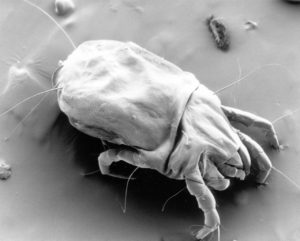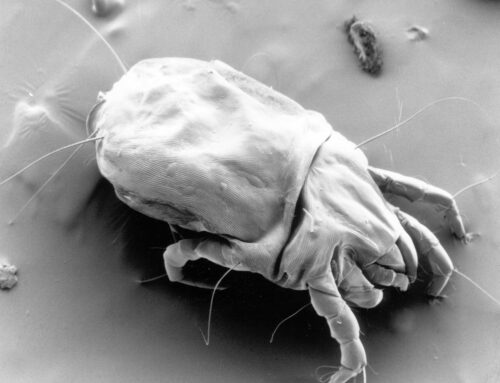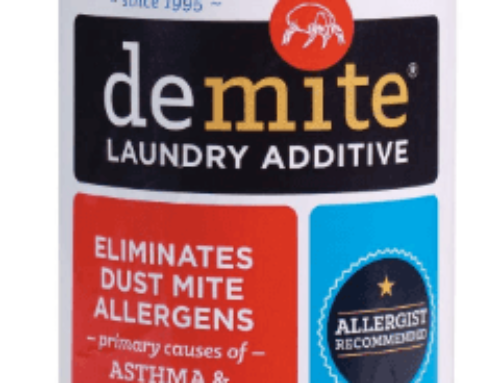Table of Contents
It’s natural to suspect that you’ve been bitten by dust mites if you woke up in the morning with red, itchy rashes on your skin. Except that dust mites don’t bite but cause a myriad of health problems all the same.
Dust mites are a common problem in many households around the world. In the US, families have to deal with the D. farinae and D. pteronyssinus species while other types of dust mites are found in other parts of the planet.
What Do Dust Mites Look Like?
You could be living with millions of dust mites under your nose and you can’t spot anything. That’s because dust mites are only a fraction of millimeters each. An adult dust mite measures an average of 0.3 millimeters, which is smaller than a pixel on your screen.
If you’re keen on getting a sight of dust mites, you’ll need to invest in a digital microscope. One that has at least 40x multiplication power is sufficient to give you a good view of the microscopic pests.
As it belongs to the arachnid family, dust mites have 4 pairs of legs, just like spiders. However, the similarity end as dust mites is whitish in color, which looks almost translucent on a microscope. Dust mites’ legs are covered with tiny hairs and they have a rather disproportionately large exoskeleton body compared to the head.
Here’s a picture of dust mites captured with an electron microscope.

Source : Wikipedia
Dust Mites Don’t Bite But What Causes The Rashes?
As menacing as they look, dust mites do not bite or claws on your skin. Neither are they bloodsuckers that drain you when you sleep. These creatures feed on the dead skin cells that you shed daily.
However, dust mites are destructive on their own, thanks to a type of protein found in their carcasses and excretion.
In the scientific community, this protein as the Der p 1 allergen. When you have dust mites in your home, the fecal pellets can be found in various places. The mattress is a common suspect, as you spent a significant duration sleeping on it.
You’ll also found dust mites allergens in carpets, rugs, upholsteries, and other areas where specs of dust gathered. A slight movement can send the allergens into the air. When inhaled, your body starts releasing histamine to counter the presence of these foreign particles.
Dust mites allergy may cause skin rashes, although it rarely happens. When it does, you’ll have red and itchy spots developing on your skin.
Often, you’ll suffer from more commonly-known symptoms, such as irritated eyes, throat, runny nose or nasal inflammation. These symptoms often started mild but deteriorate quickly if left untreated.
How Do You Treat Dust Mites Allergy
When you have rashes that look like dust mite bites, the first thing that pops up in your mind is to get some anti-rashes cream. However, if other symptoms showed up, you’ll want to consult your doctor.
Never take dust mites allergy lightly as it can aggravate asthmatic conditions in adults and cause children to develop asthma. The Asthma and Allergy Foundation of America has cited dust mites as one of the common causes of asthma.
Your doctor will diagnose the symptoms, often by performing skin tests with dust mite allergen. In some cases, blood tests are performed to confirm the symptoms. Your doctor will then prescribe the appropriate medicine for your symptoms.
Anti-histamine medicine is often used to reduce coughing, sneezing or nasal irritation. If you’re suffering from nasal inflammation, your doctor may give you nasal corticosteroids or decongestants.
Preventing Dust Mites Allergy
It’s important to treat dust mites allergy, but what’s more important is to reduce the dust mites population in your home. It’s a bad idea to keep relying on the medicines as the allergy is bound to recur when nothing is done to the root cause of the problems.
To reduce or kill dust mites in your home, you can disrupt its optimal environment or actively terminate the pests. For a start, you’ll want to reduce the humidity in your home to an ideal level for humans and not dust mites. That’s approximately 30% – 50% RH, according to National Asthma Council Australia.
Also, it’s important to keep your home clean regularly. The presence of dust often points to the abundance of dead skin cells, which fuel dust mites’ growth. Use a HEPA vacuum cleaner to remove dust mites and their excretion from the floor or mattress.
Ensure that your beddings are washed at least weekly or bi-weekly if you’re having serious allergy symptoms. Regular washing doesn’t do the trick. You’ll have to wash with hot water or tumble try in temperature above 55 °C.
It’s also helpful if you have a couple of bottles of dust mite spray in your home. Use the spray to kill dust mites and neutralize the allergens in beddings, sofas, upholsteries and other areas. You’ll know when the dust mites population is reduced as the symptoms will gradually ease off, without taking medicine.
Bottom Lines
Dust mites don’t bite although the skin rashes may seem to tell a different story. Both medical treatment and prevention steps are important to stop dust mites allergy from affecting your health.
Did you experience skin rashes caused by dust mites? What did you do to soothe the itch? Share your thoughts in the comment below.
Related:




Leave A Comment